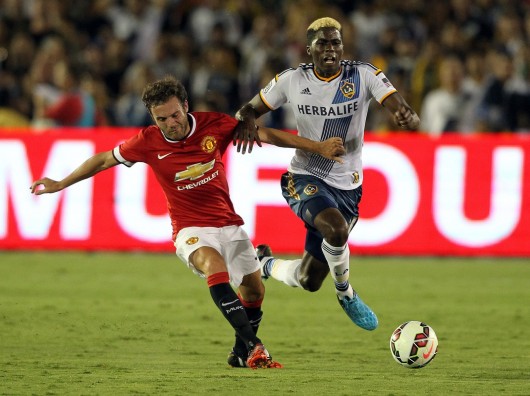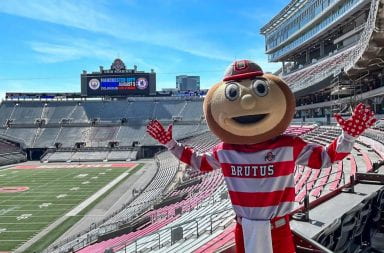
Manchester United’s Juan Mata, left, and the Los Angeles Galaxy’s Gyasi Zardes fight for the ball in an exhibition game at the Rose Bowl in Pasadena, Calif., on July 23. Manchester won, 7-0.
Credit: Courtesy of MCT
American sports fans are always looking for the next big thing.
With a number of sports trying to leave their mark over the years, soccer has seemed destined to lag behind, with legions of fans and media types wondering when it will finally reach mainstream popularity in America.
They can stop wondering.
Some may credit this summer’s highly-entertaining World Cup in Brazil, which featured the world’s biggest stars Lionel Messi, Cristiano Ronaldo and Neymar, its share of villains, like Luis Suarez and his bite or Arjen Robben and flopping, and the advantage of being one of two sporting events that the world turns to collectively.
But for the college-aged generation and younger, soccer has been a premier and attractive sport for much longer than people without a finger on the pulse realize.
Recognizing this, some of the top European clubs have flocked to America for matches that, despite the fact that they amount to what the preseason is for the NFL, are thrilling for fans. It is a perfect business model for European clubs: they see a growing market and realize they can provide a superior product than the hometown teams can.
Manchester United, the most historically successful, and hated, club of the English Premier League, went on a preseason tour of the U.S. that began with a match against the L.A. Galaxy in July. The 84,362 fans in attendance at the Rose Bowl witnessed a thorough drubbing by United, who dropped the Galaxy 7-0 in a match that certainly did no good for the MLS.
As part of the 2014 International Champions Cup — technically a tournament, although it is really only friendlies for the European clubs — United also took on Italian notables Roma and Inter Milan –– getting a victory and a draw, respectively –– before the big one: a showdown with Real Madrid in Ann Arbor, Mich.
Real, of Spain’s La Liga, have an embarrassment of riches. The club team of not only one of the most famous athletes in the world in Ronaldo, Madrid’s confines are also home to too many superstars to list. Their match against Manchester United was hotly anticipated, and it came as no surprise that it set the record for the largest turnout for a soccer contest in America.
A 3-1 final score in favor of Manchester left the mostly red-clad crowd satisfied, and although it had been declared he would not play, the subbing in of Ronaldo for the final twenty minutes had the crowd in hysterics.
With that win, Manchester United advanced to the final of the tournament
United took the title from Liverpool, another English club team on a U.S. tour, 3-1.
Liverpool’s most notable game stateside was a contest against reigning Premier League champions Manchester City –– a victory for Liverpool played at Yankee Stadium. Attendance fell just below 50,000, more than it has been for any Yankee game this season.
The teams playing these friendlies in America are not here for simple preseason warm ups. Their brand is expanding to America, and these clubs want to be here now that they see America as a cash cow. Manchester United is worth $2.81 billion, and they didn’t get there by isolating themselves — their marketing and reputation has turned them into possibly the best known sports organization in the world. Four of the top 10 most valuable franchises are European soccer clubs, with Real Madrid weighing in at $3.44 billion.
With English and Spanish teams showcasing their talents in the U.S., they remind us that there is not much reason to give much thought to Major League Soccer. The best team in MLS looked totally outclassed in their match with United. Add that to the fact that Manchester was playing more than 5,000 miles from home, and the embarrassment keeps mounting for the Galaxy.
We need to let go of the belief that MLS needs to be popular for soccer to make its mark in America. The best players in the world play elsewhere and fans have no interest in watching something that is not world class — it is the same reason we don’t care about Minor League Baseball or the Canadian Football League.
The game at Michigan Stadium is definite proof that European soccer has reached its highest level of fandom, a level that MLS may never come close to. Two foreign clubs squared off in the largest stadium in the country, and filled it to near capacity.
Maybe someday MLS will improve enough to be popular in America. For now though, American fans are content just watching Ronaldo warm up.


